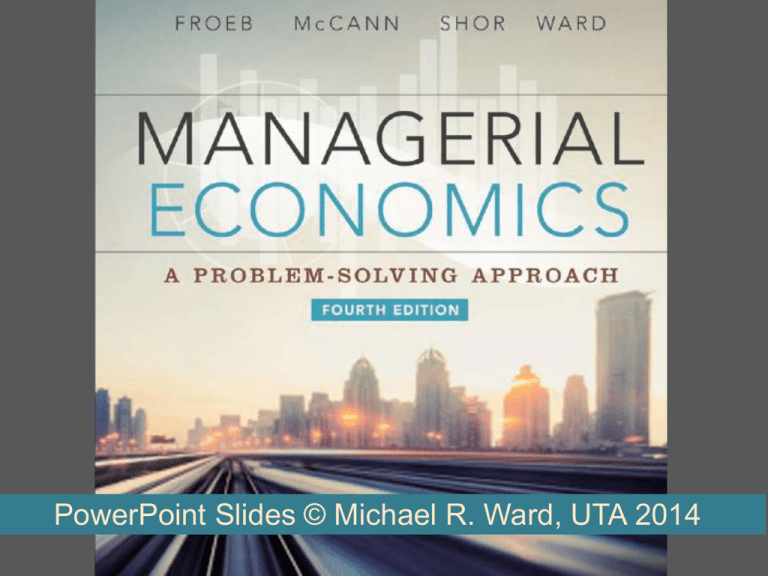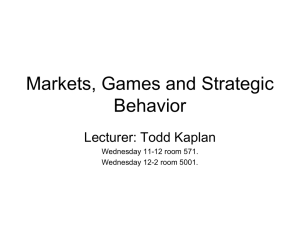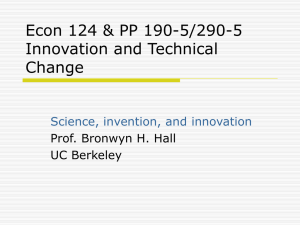ch19.slides.4e.MEAPSA.ward
advertisement

PowerPoint Slides © Michael R. Ward, UTA 2014 Econ 5313 • • • • • “The Market For Lemons” Baby Model Looking for a used car The Buyer cannot tell “lemons” from “cherries” But Seller knows Actual range of values are from $2,000 to $4,000 with each price equally likely • Average or expected value is $3,000. If the buyer offers this, he expects to do OK ½ the time (value > $3,000) and not ½ the time (value < $3,000) Econ 5313 “The Market For Lemons” • Distribution from $2,000 to $4,000 • Each is equally likely • Offer the EV = $3,000 • Expect to do come out ahead half of the time and not half of the time $4,000 $2,000 Econ 5313 “The Market For Lemons” • But will all the cars be offered for sale? • Will sellers with car values > $3,000 actually sell? $4,000 $2,000 Econ 5313 “The Market For Lemons” • But will all the cars be offered for sale? • Will sellers with car values > $3,000 actually sell? • Red portion is withheld • Green portion is relevant • Relevant distribution from $2,000 to $3,000 • Offer the EV = $2,500 $4,000 $4,000 $3,000 $2,000 $2,000 Econ 5313 “The Market For Lemons” • Offer $2,500 • Problem? • Now cars worth > $2,500 are withheld • What is the equilibrium of this market? $4,000 $4,000 $4,000 $3,000 • Price = $2,000 • The set of goods being offered are “Adversely Selected” $2,500 $2,000 $2,000 $2,000 Econ 5313 “The Market For Lemons” • The problem is “Asymmetric Information,” not just uncertainty • If seller and buyer are equally ignorant of the true value what would the outcome be? • At first stage, buyer offers $3,000 • Seller knows car could be worth more or less but does not know • On average he would be OK so he accepts • Symmetric ignorance would not be a problem here Econ 5313 Adverse Selection in Product Markets • Typology of products: • Search Goods – product quality observable before purchase • Experience Goods - product quality only observable with use • Credence Goods - product quality may never be revealed • Products have a mixture of both search and experience characteristics • As an economy matures, there is greater demand for quality • Usually these are experience characteristics that result in adverse selection problems • How do you sell products with important high-quality characteristics when the quality is not directly observable? Econ 5313 “Hostage Taking” (& Offering) • Solution must involve keeping the transaction open until information becomes symmetric enough • Often requires the seller to “Offer a Hostage” • Example Two city-states ganging up on a third • Business Context – Devise a contract in which the sellers of low quality products suffer disproportionate harm • Signaling Examples: • • • • Bonding – e.g. home repair by tradesmen Warranties/Guarantees – cheaper if better quality Reputation – e.g. professional services, lawyers Advertising – “buy” a reputation to lose Econ 5313 Insurance • Adverse selection is fundamental in the insurance market • The demand for insurance comes from consumers who do not like risk • We model risk as a random variable with a payment attached to each outcome • A risk-neutral consumer values a lottery at its expected value • A risk-averse consumer values it at less than its expected value • Consider a coin flip • The payoff from heads is $100 and from tails is $0 • A risk-neutral consumer would value it at $50. • A risk-adverse consumer would value the lottery at $40 • Insurance moves “risk” from the risk adverse consumer (lower value) to a risk neutral insurer (high value) Econ 5313 Insurance • So insurance is a wealth creating transaction, except that it moves a “bad” from someone who doesn’t want it (risk averse consumer) to someone who willing to accept the risk for a fee (insurance company) • Numerical example: Rachel owns a bicycle valued at $100 • The bike has a possibility of being stolen, meaning Rachel’s payoffs are lose $100 if it’s stolen, lose $0 if it isn’t • If the probability of theft is 20%, then the expected cost of the lottery is 0.2×$100 = $20 • An insurance policy for the value of the bike costs $25, eliminating the risk of owning a bike Econ 5313 Insurance • If she is risk averse enough she buys the insurance • Say she values the insurance at $30 • Both insurance company and Rachel are better off with this policy • The company earns $5 (=$25-$20), on average, and Rachel can stop worrying about bike theft • She “pays” the insurance company $25 each year so she doesn’t have to face the risk of bike theft and has surplus of $5 (=$30-$25) Econ 5313 Insurance • Note that the insurance company never actually earns $5 on any given transaction • Either the company loses $75 if the bike is stolen, or earns $25 if it is not • The expected value of offering insurance, though, is $5 $5 = 0.2 × ($-75) + 0.8 × $25 • Because they write so many offsetting policies, insurers actually face little overall risk and so are risk neutral Econ 5313 Insurance • To explain on adverse selection, we modify the bike example • Now suppose that there are two equally sized risk-adverse consumer groups: • Group 1 with a probability of theft of 0.2 • Group 2 with a probability of theft of 0.4 • What happens when you try to sell insurance at a price of $35 (to average across groups)? • Who is willing to pay $35? • Because only high-risk consumers would be willing to pay the higher price, the company would consistently be paying out claims Econ 5313 Insurance • Anticipate adverse selection and protect yourself against it • This means anticipate that only the high-risk types will buy, so price the insurance at $45 • This also means that the low-risk types may go un-served in this insurance market • Analogous to withholding the more valuable cars • Example For health care insurance, which is the largest group among the uninsured? • Healthy 20-somethings because insurance premiums are not worth it • We had to pass a law to force them to buy Econ 5313 Futures Markets • One main function of the financial industry is allocating risk; moving risk from lower- to higher-valued uses • How do futures contract re-allocate risk? • Farmers face two forms of risk: 1. 2. Output risk – under his control Price risk – out of his control • Most of a farmer’s expected Fall harvest can be sold in the Spring before he plants • Deals with price risk • Why are buyers of commodity futures contracts better able to absorb the risk? Econ 5313 IPOs • In financial markets, adverse selection becomes a problem when the owners of a company want to sell shares to the public but know more information about the prospects of the company than potential investors • Potential investors should anticipate that companies with poor prospects are most likely to sell to the public • For example, small initial public offerings (IPOs) of less than $100 million lose money, on average, whereas large IPOs have “normal” returns • The winner’s curse of common-value auctions is also a type of adverse selection (later) Econ 5313 Partial Insurance • In the bicycle example, if the insurance company sells policies at $45, low-risk consumers are un-served • But these consumers would be willing to pay $25, which is still more than the cost to the company of insuring the bike, $20 • Adverse selection presents many potentially profitable and unconsummated wealth-creating transactions • Can you devise a way to serve them without falling victim to adverse selection? • Using screening or signaling can help overcome the adverse selection problem so that low-risk individuals can be transacted with profitably Econ 5313 Screening • One solution to adverse selection is to gather information to distinguish high-risk from low-risk consumers • Screening is an effort by the less-informed party to induce of consumers to reveal their types • But this can be difficult and costly to do • Privacy and anti-discrimination laws frequently prevent insurance agencies, and other companies, from gathering or using certain information (race, gender, credit scores) • Sometimes indirect methods can be used • Information may be gathered indirectly by offering consumers a menu of choices, and consumers reveal information about their risks by the choices they make Econ 5313 Screening • Screening is frequently used in the insurance market • Example High-risk individuals prefer full insurance at $45, to partial insurance (for instance receiving only $50 if your bike is stolen) at $15 • For a successful screen, it must not be profitable for the high-risk consumers to mimic the choice of the low-risk consumers • Screening reduces the information asymmetry and so may allow the consummation of previously unconsummated wealth-creating transactions Econ 5313 Screening • Owners of good cars are analogous to low-risk insurance consumers – they are unable to transact • How can this unconsummated wealth-creating transaction be consummated? • In other words, how can you design a screen for those who want to buy a “cherry,” and not a “lemon?” • One option is for the buyer to get a mechanic’s opinion • The cost of “an expert opinion” may be much less than the cost of a lemon • Also, the lemons owner might balk and such a request Econ 5313 Marriage Screens • Louisiana offers a choice between two marriage contracts: a covenant contract which makes divorce expensive; and a regular contract which makes divorce relatively cheap • How does Louisiana marriage law function as a screen? • What is adverse selection problem in marriage? • Recently, Mexico has proposed a different type of marriage that expires after three years. • What adverse selection problems might you foresee? Econ 5313 Engagement Ring Screens • Diamond engagement rings were not common 100 years ago • “Progressive” reforms removed law suits for damages from jilting the bride at the altar • What damages? • How does demanding the ring solve the problem? • Hint Some brides and grooms lived as wives and husbands prior to marriage. • Hint What do future suitors infer about the would-be spouses who had been jilted? Econ 5313 Incentive Compensation as a Screen • Some sales people are hard workers and will sell 100 units per week, and others are lazy workers, who will sell only 50 units per week • Asymmetric information means only workers known if they are lazy or hard working • Because both types of employee will accept an offer of $800/week, you will attract a mix of lazy and hard workers • How does commission fix this? • Incentive pay ($10 per sale) solves the problem: hard workers earn $1000 and lazy workers will reject the offer (they expect to earn only $500) Econ 5313 Incentive Compensation as a Screen • Incentive pay imposes risk on the workers – some sales factors are out of their control • Have to pay risk averse worker to accept this risk • Another screen with less risk: offer a base salary of $500 plus $10 per sale for every unit above 50 sales Econ 5313 Signaling • Another solution to adverse selection is to credibly reveal information to distinguish which group they are in • Signaling describes the efforts of the more informed party (consumers) to reveal information about themselves to the less informed party (the insurance company) • A successful signal is one that bad types will not mimic • How can a screen be used as a signal? • Low-risk consumers could offer to buy high deductible insurance, good employees could offer to work on commission, and cherry cars sellers could include a warranty with the purchase Econ 5313 Education as a Screen • Some of the value of education is in its signaling value • Students can signal employers that they’re hardworking, quick-learning, dedicated, etc. by spending the time and money necessary to pursue an education • Could this work even if the education does not make them any more productive? • We hope it does make you more productive though • (There is evidence for both the signaling and the productivity theories) Econ 5313 Car Selling • Owners of good cars are analogous to low-risk insurance consumers or high quality students • How can owners of “cherries” sell their cars for a price reflecting their quality? • What signals do car owners send to distinguish a cherry from a lemon? • One option is to offer a money-back guarantee • The cherry owner knows that it won’t be returned so the guarantee costs little • The lemon owner knows that it could be returned so the guarantee is costly Econ 5313 Brand Advertising as a Signal • Firms brand and advertise products to signal quality to consumers • As a result, most consumers are now willing to pay more for branded and advertised goods • Low-quality firms won’t find it profitable to advertise because once consumers use the product and notice the difference, they will switch brands and the firm will have wasted money on the advertising • Note that some states prohibit advertising, e.g., for financial advisors, that would serve as a signal of quality • Example Pearl Vision Econ 5313 Dressing Up as a Signal • Dress appropriately to signal quality to potential employers • As a result, employers infer you are a serious job candidate • Low-quality job candidates know that they are not likely to get much use out of a business suit • “I’d never want to join a club that would have someone like me as a member” – Groucho Marx • Also goes for knowing appropriate business etiquette • Preening and dressing for a first date is also a form of signaling Econ 5313 Other Examples Business Cards • How much do you know about business cards? • American Psycho: Business Card Scene Interviewing • Of course, both the Interviewer and the interviewee are sending signals at job interviews • Strange Wilderness: Hiring Scene Econ 5313 Ebay • Sellers have better information than buyers about the quality of goods being offered for sale • Anticipating adverse selection leads buyers to offer less, which makes sellers less willing to sell high quality goods • Consummated transactions are more likely to leave buyers disappointed in the quality (“lemons”) • How does eBay try to solve this problem? • By providing: • Escrow services • Fraud insurance • Seller ratings – provided by past buyers Econ 5313 Pre-hire Training • South Carolina manufacturing firm hiring new employees • Requires 24 unpaid classroom hours over 8 days in 4 week period • Final step before full-time employment • If candidate is tardy, he/she is sent home and not allowed to return • Results: • Of 30 people, two candidates are sent home • Only ten of the 1,300 workers hired under the program have had significant attendance issues • Program reduced the rate of bad hires from about eight percent to less than one percent • Signal or Screen? Econ 5313 • • • • • • • • From the Blog Chapter 19 100 fake pennies for only $3.49 Is being a woman a pre-existing condition? Photos help sell online products Speeding Ticket Insurance Employer Incentives under the ACA Who goes double-down against a Carny? Who Buys Lottery Tickets Econ 5313 Main Points • Asymmetric Information introduces more problems for voluntary exchange than mere uncertainty • One aspect of asymmetric information is adverse selection in which primarily low values select into transactions • This means that some assets are stuck in low value uses which means … a potential profit opportunity • Realize these profits be devising ways to screen or signal quality • Adverse selection is a major problem in: financial markets, employment markets, product markets, mating markets, and …










